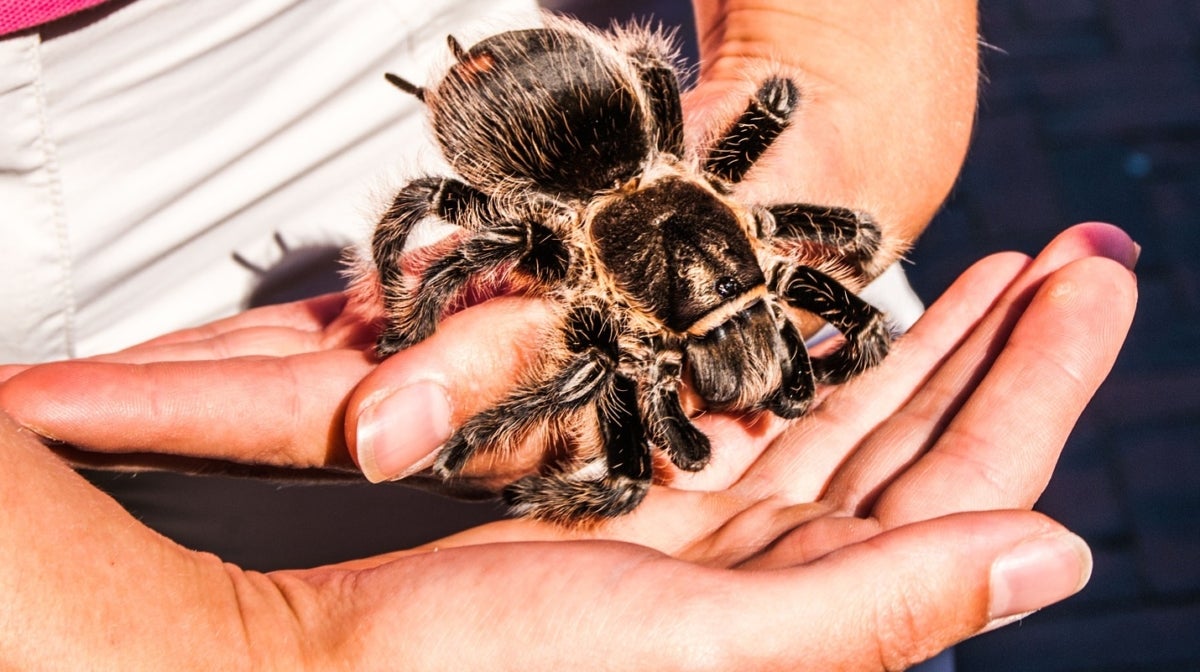The Beginners Guide to Keeping Tarantulas as Pets

Tarantulas can make surprisingly good pets - assuming you're not afraid of spiders!
Many of the more common species are quite simple to look after, are docile-enough to be handled and some specimens can live for over 20 years.
In addition to this, tarantulas tend to be quite clean animals, make little or no noise and require minimal regular maintenance. They can therefore be ideal for those with minimal space or time, but who'd like something a little but "different" as a pet.
The Equipment List
Tarantulas are exotic pets, and as a result they require rather more specialist care than, say, a hamster.
If your spider is to live a long and healthy life, here's a list of the equipment you'll want to have at home...
Tarantula Tank
First and foremost you'll be needing a suitable cage for your spider. Most exotic pet shops sell specialist spider tanks these days, or you might even manage to find one here on Preloved.
Generally speaking a spider tank will be made of glass, with dimensions of around 12" long by 8" deep. One popular brand to keep an eye out for is Exo Terra. It's important that they have a secure lid, as tarantulas can be surprisingly good at climbing. This tank should be cleaned with a reptile-safe detergent spray before use, and the same substance can be used for future cleaning.

Heater
Tarantulas typically come from the warmer parts of the world, and are cold blooded, so some artificial heating will be required.
This needn't be as difficult - or as expensive - as you might first think. One of the easiest heaters to use is a heat pad. These are thin pieces of plastic, with a wire coming out of one end. Once plugged in they produce a gentle, background heat and cost just pennies per day to run.
Substrate
The base of the tarantula cage should be lined with a suitable material. Doing so doesn't just look good; it also allows your pet to behave more naturally, by burrowing and re-arranging it to suit its needs.
In the past a range of different tarantula substrates have been used. Possibly the most effective solutions are a chemical-free potting compost or coir. Coir is made from coconut shell, and can be bought in many pet shops as a condensed "brick". Simply soak it in water for a few minutes and the material will expand. Drain off the excess water and you have a perfect substrate for your spider.
Spray Gun
The right humidity is almost as important as the right heat for your tarantula. Dry cages can kill tarantulas, especially when they try to change their skin (something that adults normally do once a year). A plant spray gun can be used to give the cage a gentle spray from time to time, helping to keep the inside humid.
Be aware that tarantulas can be very sensitive to household chemicals. It is therefore a good idea to buy a new spray gun, and carefully label it, purely for your tarantula. In this way you can be certain that it is not used for other purposes around the house.
Thermometer/Hygrometer
Low-cost thermometers can be used to monitor the temperature in your tarantula tank. Ideally you'll want the hottest area of the cage to sit at around 25'C. Additionally, a hygrometer can help you measure the humidity, aiming for around 70-80% humidity. These can often be purchased in combined units for just a few pounds.
Water Bowl
While tarantulas don't drink often it is considered good form to always make water available. A shallow bowl, as sold for hamsters, can be ideal. Be sure to wash the bowl and change the water regularly to keep it fresh.

Hide
If there's one thing that most tarantulas have in common it's that they can be surprisingly shy and retiring animals - quite the opposite of the fearsome creatures they're made out to be in the movies.
It is kind, therefore, to provide somewhere private so your spider can hide away during the daylight hours. While reptile shops sell quite a wide range of hides, a cheaper solution can simply be half-burying a suitably-sized plastic plant pot - lying on its side - in the cage. This acts like a small "cave" and can give your pet the privacy it desires.
Food
It's no secret that tarantulas are carnivores, and will require live insects to eat. Before buying a tarantula you should research the subject thoroughly, so that you know where you can buy them from. Alternatively, a number of websites sell live foods by post.
Broadly speaking tarantula food comes in tubs. A range of options are available, with crickets and locusts being particularly popular. Aim for insects no more than half the length of your spider.
Tarantulas cannot be overfed, so feel free to feed your spider as often as they will eat. As a broad rule, start with twice a week for adults. The food should be eaten within a few minutes of introduction; don't leave uneaten insects in the cage for long periods as this can stress out the spider, and cause problems with moulting.
It is a good idea to keep a diary of when your tarantula eats. A spider that goes off its food for some weeks is normally coming up to a moult. By monitoring this you'll be able to predict a skin change, and pay particular attention to your spider during this period.
How to Set Up Your Tarantula Tank
Setting up a tarantula tank is reasonably simple once you have all the necessary equipment. Firstly, place an inch or so of substrate in the base of the tank, then place in the hide and water bowl.
The next (critical) step is setting up the heater correctly. Here there are two solutions. You can either rest the rank on top of the heater, or tape it to the outside (such as one end of the cage). Here's the important point - you don't want to heat the whole cage. Why not? You want to create a "gradient" - with some end warmer than the other. In this way your tarantula can move about naturally, selecting the area that suits them best.
This means that you'll want to just heat 1/3 to 1/2 of the cage. For example, if you're placing the cage on the heater then just place it half on, and half off.
Pop your thermometer in, close the lid and then monitor the cage. If you hit a comfortable 24-26'C at the hot end then you're all good to go!
As a quick note, its important to mention that tarantulas tend to be cannibalistic. As a result they're kept alone. Don't feel guilty about your spider getting "bored" - if you give him a playmate you'll normally end up with just one, very fat tarantula!
Choosing a Species
There are now over 800 tarantulas known to science. While only a tiny handful of these are common in the pet trade this does mean that the potential tarantula keeper has quite a decision to make.
The most popular first tarantula is the Chile Rose - a sturdy, low-priced and very docile species. New keepers are best to stay away from one of more exotic species until you have gained some experience. At this point, however, there are a vast number of dazzling species that can be kept - from the dinner-plate sized Goliath Birdeater to the incredibly-coloured Green Bottle Blue.
Can I Handle My Tarantula?
One of the most common questions that we tarantula-keepers get asked is whether you can handle a tarantula.
Here there are a number of factors to consider. Firstly, not all tarantulas can be safely held. Some are much faster, or more aggressive, than others. Examples of slow-moving and docile spiders which can be held include the Chilean Rose, the Curly Hair and the Mexican Red Knee. If you plan to handle your tarantula, check in advance whether or not you're buying a species suitable for such an activity.
Secondly, opinions are divided on how safe this is for tarantulas. A tarantulas abdomen is surprisingly fragile, and dropping a tarantula from a height can be disastrous. If you do opt to handle your tarantula, therefore, aim to do so while holding it over a soft surface - such as a bed - so that if your spider falls it won't damage itself.
The method for handling a tarantula is quite simple. The easiest method is to place your flat hand into the cage near your spider, and then gently coax it onto your hand, using a pen as a guide. Once there, gently lift the spider up and be ready to swap hands as the spider walks.

Conclusions
I've been keeping tarantulas for over 20 years now, and think they're one of the very best pets around. You'll be privvy to a glimpse of their private lives as you can watch them hunting, eating and changing their skins in the comfort of your own home.
Like any pet, keeping a tarantula comes with responsibilities. That said, their care requirements are pretty minimal, making for a low-effort pet. Like many others, you might even find yourself turning into quite a collector over time - very rarely does the spider enthusiast stop at a single animal!
We asked Richard whether he knew of any exotic pet rescues we could share with readers, we were shocked to learn that there aren't that many at all! The two he recommended are Proteus Reptile Trust in the Midlands and a specialist RSPCA reptile unit in Brighton. Check out Preloved if you would like to rehome a tarantula.
Richard Adams is a British tarantula enthusiast who has been keeping and breeding exotic pets since the early 1990's. Today he blogs about his passion at Keeping Exotic Pets.









